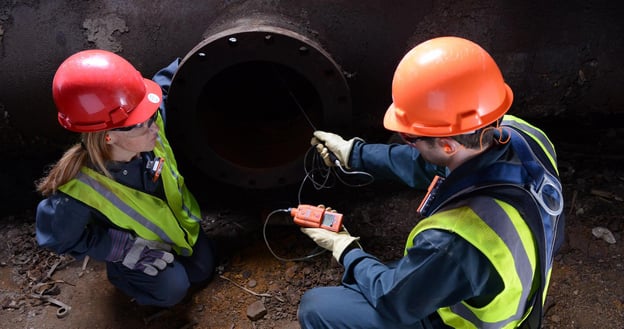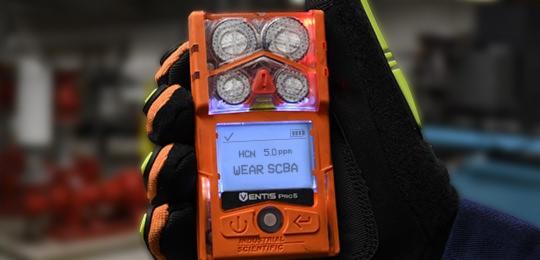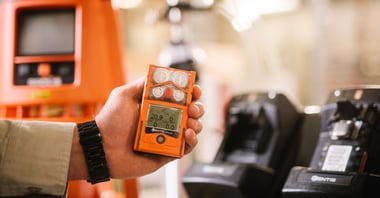Personal multi-gas detectors are very popular, and for good reason. Four-gas monitors and five-gas monitors allow you to detect the three primary gas hazards: toxic, combustible, and asphyxiant gases, while also giving you the flexibility to customize your sensor configuration to the gas hazards you’re most likely to encounter in your environment. With personal multi-gas detectors, you get a lot of coverage in one wearable device.
When you’re looking for a gas detector to serve your needs, you need to ask two questions: What can the gas detector do, and how can it make my job easier?
While there is no “perfect” gas monitor that will detect every possible combination of gas hazards, a multi-gas monitor is a good place to start.
It’s not enough to simply know what features your multi-gas detector has and what they can do. You must be aware of how your gas monitor will be used on the job, and which features will be useful to you. By understanding each multi-gas detector and how it can function on site, you can better understand which type of gas detector best suits your needs.
Here, we’ll compare two of our most popular multi-gas detectors: the Ventis® MX4 and the Ventis® Pro5.
Ventis MX4 Four-Gas Monitor
The Ventis MX4 is a reliable four-gas monitor with the portability and size of a single-gas monitor. The Ventis MX4 can detect up to four of the following gases simultaneously:
- Combustible gases and lower explosive limits (LEL)
- Carbon monoxide (CO)
- Hydrogen sulfide (H2S)
- Oxygen (O2)
- CO/hydrogen (H2) low
- Sulfur dioxide (SO2)
- Nitrogen dioxide (NO2)
The Ventis MX4 is designed to be extremely rugged yet lightweight, making it easy to wear for long shifts. You can also customize your run-time with different batteries, personalize your device by selecting alarm thresholds, and enjoy a four-year warranty on the monitor and select sensors.
As a multi-gas detector for everyday use, the Ventis MX4 offers both pumped and non-pumped functionality. With the Ventis MX4, you eliminate the need for additional monitors for other applications, as it transitions from personal monitoring to confined space monitoring with a slide-on pump. Buying one monitor that can do both is more cost effective in the long run. On top of that, it reduces the number of devices workers need to use to get the job done, making everyone’s lives just a little bit easier.
 The Ventis MX4 is compatible with iNet® Control software, the DSX Docking Station, and can be placed on an iNet® Exchange agreement, which means you can automate maintenance, reporting, and data tracking so you can spend more time applying insights to make your site safer, and less time repairing gas detectors or sifting through paperwork.
The Ventis MX4 is compatible with iNet® Control software, the DSX Docking Station, and can be placed on an iNet® Exchange agreement, which means you can automate maintenance, reporting, and data tracking so you can spend more time applying insights to make your site safer, and less time repairing gas detectors or sifting through paperwork.
Ventis Pro5 Five-Gas Monitor
With all that the Ventis MX4 has to offer, why should you consider the Ventis® Pro5? Much like the Ventis MX4, the Ventis Pro5 is ideal for both personal monitoring and confined space entries thanks to the available pump options. In fact, both gas monitors are compatible with the same slide-on pump.
Where the Ventis Pro5 steps ahead of the Ventis MX4 is its connectivity. This wireless connectivity adds an extra layer of protection and visibility to an already robust multi-gas detector.
Using a five-gas monitor like the Ventis Pro5 allows you to advance the level of detection, giving you better awareness of the gas hazards around you. The Ventis Pro5 is, of course, capable of detecting even more gases than the Ventis MX4 and allows DualSense™ capabilities. This feature uses two sensors to provide a single reading to overcome the challenges of sensor failure and improve reliability.
With the Ventis Pro5, you can set custom, actionable alarms for up to five of the following gases:
- LEL (Methane)
- LEL (Pentane)
- Chlorine (Cl2)
- CO
- Carbon dioxide (CO2)
- H2S
- Hydrogen cyanide (HCN)
- NO2
- Ammonia (NH3)
- O2
- Phosphine (PH3)
- SO2
- Volatile organic compounds (VOCs)
These custom alarm messages make it easy for users to respond appropriately and quickly to gas hazards. For example, you can customize the alarm to tell users to “evacuate” or “wear SCBA” depending on the gas and threshold.

With a man-down alarm, panic button and extensive connectivity capabilities, you and your workers can be confident that they will get the help they need in the case of an incident. Wireless connectivity relays gas readings and other worker safety stats to live monitoring software via cellular, wi-fi, satellite, or to your co-workers on site with LENS® Wireless. You can then receive real-time alerts that show who needs help, why they need help, and where they’re located. Whether you’re working side-by-side or far apart, the Ventis Pro5 keeps you and your workers on the same page – wherever you are.
In addition to the connectivity and live monitoring features covered above, the Ventis Pro5 is also compatible with iNet Control, the DSX Docking Station and can be placed on an iNet® Exchange agreement, giving you easy access to critical gas detector data and eliminating the hassle of maintenance and repair.
Ventis Pro5 is the Way to Go
On a basic level, many multi-gas detectors have similar capabilities: they detect hazardous gases. With so many different gas hazards to detect, it’s important to understand the environment around you. When you know which hazards you want to detect, that makes it easier to choose the right multi-gas detector.
You can differentiate the monitors by looking at the gases they detect and their additional safety features. For next-level safety from your gas detector, the Ventis Pro5 has you covered. With alarm sharing, live monitoring, panic button and man-down functionality, the Ventis Pro5 offers additional lifesaving safety features. Not to mention, it can detect more gases at a time and a wider variety of gases compared to the Ventis MX4.
If you already have a Ventis MX4 or need a variety of gas monitors, it’s easier than ever to upgrade to the Ventis Pro5 or switch between detectors depending on your application because of their shared accessories. This allows you to take advantage of the connectivity of the Ventis Pro5 while cutting down on additional upgrade costs. Both use the same slide-on pump, DSX Docking Station, and more.
The Right Equipment for the Job
While technology and features in a gas detector cannot eliminate every safety challenge, they do make it easier for you and your workers to stay safe on the job by eliminating guesswork. Choosing the right gas detector to protect your workers can be a challenge, but by being informed and getting advice from experts it can be an easier and more effective process.
Whatever your needs are and whatever you face on site, our experts are here to help you find the right gas detector for your needs.



